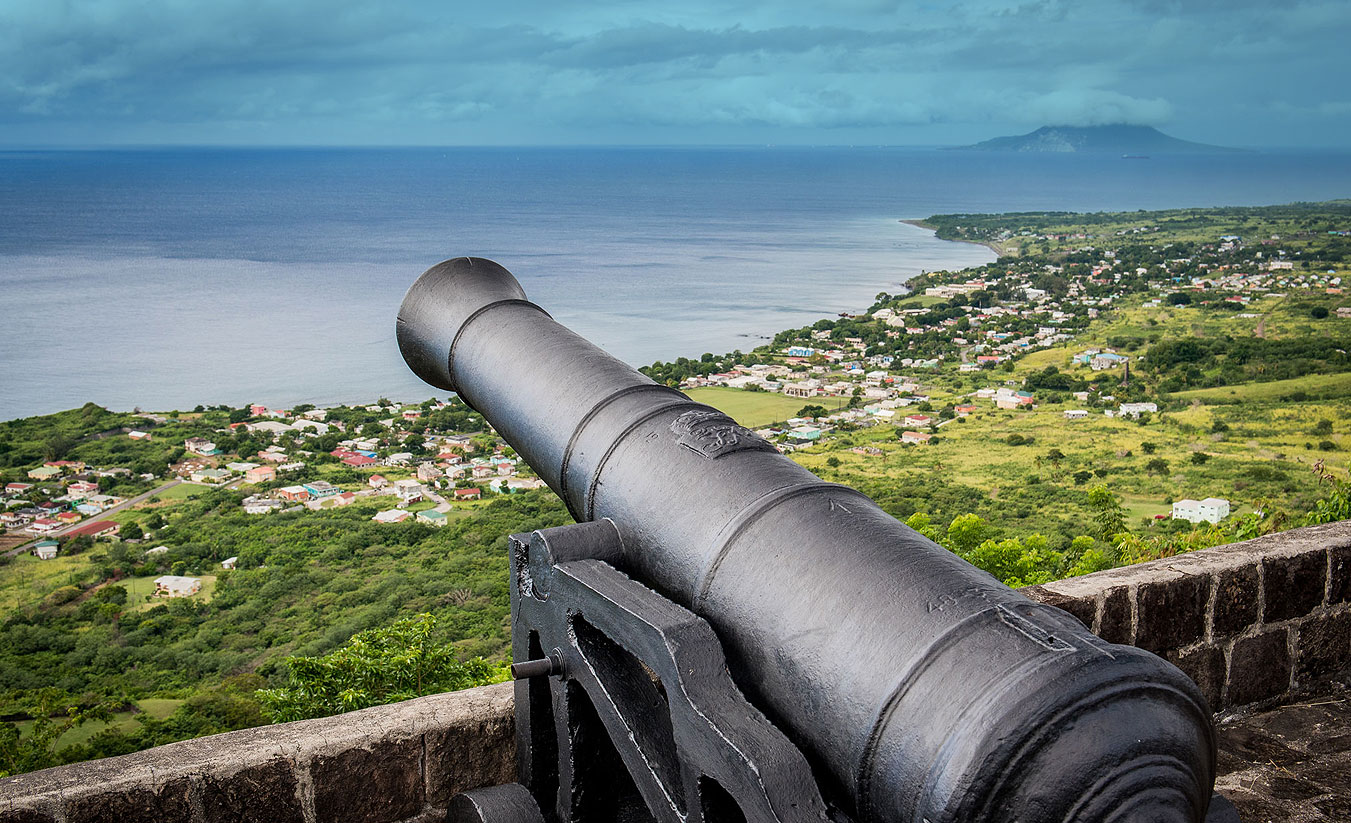The Westley Chapel
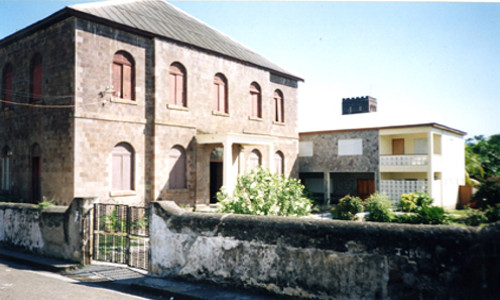
The Westley Chapel, also referred to as the Methodist church, is a solid square stone building located on Seaton Street just off of Victoria Road. It is slightly to the north of St. George’s Anglican Church.
Methodism arrived in St. Kitts late in the 18th century. On the 18th January 1787, Thomas Coke and three Methodist missionaries, Messrs Baxter, Hammet and Clarke arrived in St. Kitts from Dominica. News of their intended visit had preceded them and they were provided with accommodation by Lydia Seaton and Richard Cable a printer and William Bertie, a jeweler. Both Seaton and Cable were Antiguans of mixed race who adopted the Methodist philosophy and later had moved to Basseterre, St. Kitts. The visitors were all invited to address an audience at the Court House, then still on Church Street. Attendance was encouraging and later a number of prominent gentlemen, including the Anglican cleric in charge of St. George’s welcomed them to their homes.
Preparations were then made for William Hammet to remain as missionary on the island. Before the year was over, he had purchased the land now occupied by the Wesley Chapel from its owner, Elinore Doyle. The following year he conveyed the land to a Board of Trustees which included Richard Cable, William Brazier, Stephen Lynn, George Skerritt and John Percival. A wooden chapel was erected and it was enlarged in 1803, a project that cost £600. The membership of the new denomination grew rapidly from 700 in 1789, to 1554 in 1793, to 2587 in 1807 with the majority being persons of African descent and of mixed race. In 1822, a building of dark stone measuring 75 feet by 55 feet that could seat a congregation of 1500 replaced the wooden structure. The Chapel survived the numerous disasters that caused so much damage in Basseterre over the years that followed its construction and is now the oldest public building in the town.
In 1831, a manse was built to the south-west of the chapel but its proximity to College Street proved its undoing during the flood of 1880. In 1883, the Reverend T. Meade Chambers laid the corner stone of the present manse at a much safer distance from the ghaut but on land that the Anglicans claimed was part of their cemetery. The dispute was eventually settled amicably.
During the centenary celebrations of 1925, the Minister in charge drew the congregation's attention to the fact that the chapel’s roof needed replacing and announced that the funds raised during the celebration would be devoted to that project. The hurricane of the 12th September 1928 caused extensive damage. Renovations followed. A new steel roof was made to order in Liverpool, England, the galleries and rostrum were replaced and a vestry and two porticos were constructed. Electricity was also installed. Much of the work was undertaken by Charles Mills of Sandy Point.
In 1984, the Reverend John Gumbs undertook the construction of the annex. It provides office space, meeting rooms, a robing room and until recently a kitchen for the Meals-on-Wheels programme.
Then in 1998, Hurricane Georges once again caused serious damage to the roof and the interior. Renovations and repairs were estimated in the region of one million dollars. Work started in September 1999. The refurbishment project was managed by civil engineer Arthurlyn Belle who was assisted by Lawrence Elmes and Eustace "Stacey" Hobson, all members of the church. the renovations included the installation of a Junior Choir loft and four stained glass windows. The Chapel was rededicated on the 18th August 2002. While the work was going on, services were held in the Church Hall which, up to 1991, had housed the Boys' School.
Further reading
Thomas Coke A history of the West Indies ... with an account of the missions institututed in those islands (Liverpool, 1808)
Sir Probyn Innis, Methodism in St. Kitts: 1787-2006, (Basseterre, The Author, 2006)
Warner Park

Warner Park is bordered by Losack Road on its south side, Victoria Road in the west, the Basseterre High School on the northern side and Park Range to the east. Originally it was part of an estate owned by the Losack family, a French family that continued to live in St. Kitts after the British gained control of the whole island. In 1817, the Original List of Slaves records a return of seventy-one slaves made by John Malzac on behalf of Admiral George Losack then owner of the Lozack plantations on the island. Eleven of them were born in Africa. Thirteen were too young to work and two were infirm. Among the remainder there were an overseer, a driver, two boilers, a cooper, a distillers and a carpenter. Except for a few house servants the rest worked in the field.
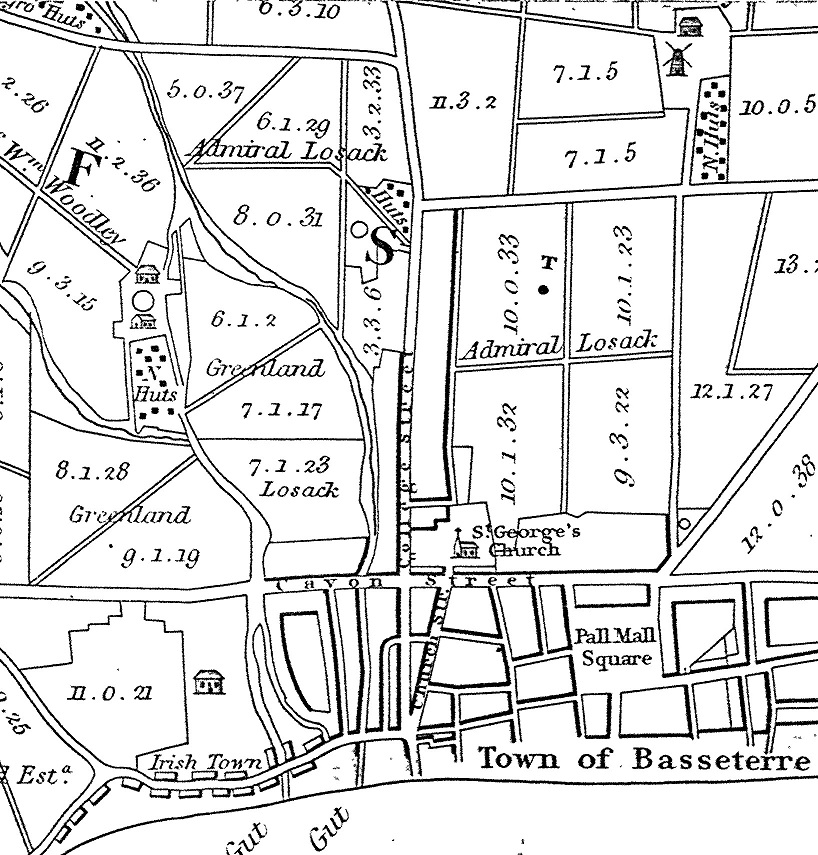
In January 1867, even before the great fire of that year, the administration recognised the importance of the land that is now occupied by Warner Park and the Basseterre High School. Flanked as it was by a number of significant buildings – the Moravian, complex, Government House, The Poore Memorial School, The Grammar School, the Methodist Chapel, St. George’s Anglican Church, the Police Station and the jail – it was enacted that the land would not be planted to discourage cane fires near these properties. Part of the property was going to be used for housing to relieve the congestion in Irish Town and Newtown. In 1887, while preparing to celebrate the Queen's jubilee, the Executive Council was in favour of the acquisition of the field in front of Government House so that it could be turned into a park to be called Victoria Park. The following year, the ide of the town extension was revived but this time the idea of building a 35 room hotel was introduced. It was estimated that the project would have cost £6000. However the price for the land demanded by Edwin Wade was more that the government was willing to pay. The hotel project was shelved in 1895 when the price of sugar dropped dramatically. The town extension took place to the west of Basseterre instead.
When the Government bought the property to build the park in 1926, it was a part of the Wade Plantations which included College, Douglas, Dalzell’s, Golden Rock, Hermitage, Pogson (St. Mary) and Spooner’s. These were estates acquired during the 19th century by Solomon Wade. But before the acquisition could be made the money for its purchase had to be raised.
On the 28th January 1923, St. Kitts celebrated the 300th Anniversary of the arrival of Thomas Warner and his group of colonists. This was the beginning of the first successful English attempt to establish a colony in the Caribbean islands. The Post Master, George H. King had the idea of using this opportunity to raise funds for the construction of a recreation ground close to the town centre. Therefore to commemorate the occasion, the administration authorised the issue of a special stamp depicting Old Road Bay, with a 17th century ship in the foreground and Mount Misery in the background.
The sale of the Tercentenary Stamp issue raised £3,916 of which £1,400 were used to purchase 14 acres of land from Mary Wade, then owner of Losack Estate. The remainder of the sum was used to fence the area, plant trees and sow seed for cricket, football and tennis grounds. The foundations stone for Warner Park was laid by Governor Sir Eustace Fiennes on the 21st April 1926. Management was placed in the hands of a committee. Its members where G.C. Johnson, Clement Malone, B. Marshal, A. M. Reid, E. J. Shelford, George King, D. F. Matheson, Landreth Smith, J. Yearwood, A. Davis, T. R. Shepherd, Basil Davis, J. M. Sebastian, J. Nathan and M. Morris.
C. G. Thibou, Surveyor of Public Works designed and oversaw the construction of the Pavilion which was opened in 1928 in time for the Leeward Island Cricket Tournament. The Park became the stage on which great cricketers like Paget Berrridge, Austin Eddy, George McMahon, Len Harris, Edgar Gilbert, Victor Eddy, Luther Kelly demonstrated their talents and built their reputations
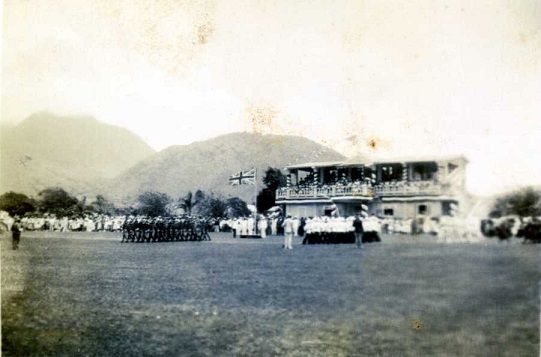
George King who served as Chairman of the park Committee for a number of years did an admirable job. Unfortunately, he may have become a little over protective and saw his role as one of controlling access to this public place. In 1942 when he was chairman of the Park Committee he attempted to chase away a group of children from the Boys’ School who, under the supervision of three teachers, went there to learn the school song. A court case brought by the parents of three of the children was decided in their favour and from then on the Park became a truly public place.
Leaders of the Workers League (later the Labour Party) often used it to address to their supporters. The Entertainment Committee of the St. Kitts Nevis Trades and Labour Union under the leadership of Horace Slader held annual sporting events there to celebrate Labour Day. From 1957 the Park became the venue of carnival, first organised by Basil Henderson. In the 70s the Upper House started claiming the Park as their meeting place. This was a group of men from all walks of life who frequented the park as spectators, participants or simply as a place where they could relax and discuss anything from world politics to the escapades of an acquaintance. Their yearly Christmas party is a big closed event. Nationals visiting during the season may be invited to participate.

The Park became central to the festivities associated with the anniversaries of the achievement of Statehood and from 1983 of Independence and it became the place for the ceremonial parades that accompanied Royal and State visits.
St. Kitts hosted CARIFESTA in 2000 and the Park was the scene of both the opening and closing events. In 2004 Warner Park was chosen as one of the venues to host games of Cricket World Cup in 2007. This lead to a complete renovation and in 2006 the Park hosted its first international cricket match between the West Indies and India. In 2007 Australia, the Netherlands, Scotland and South Africa played games here as part of the World Cup tournament. Since then Warner Park has also become the venue of the St. Kitts Music Festival.
The University Centre and Technical College
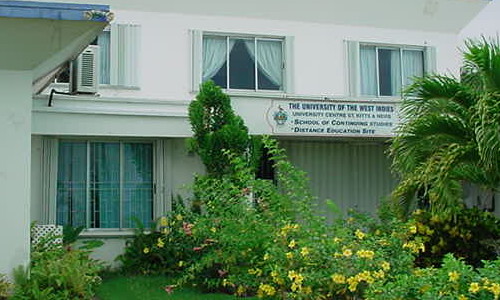 The University Centre and Technical College occupy an area at the western end of the Bay Road, just east of the War Memorial.
The University Centre and Technical College occupy an area at the western end of the Bay Road, just east of the War Memorial.
Although the western boundary of Basseterre stretched to Fort Thomas in 1768, only dwellings in Irish Town extended beyond Olivees Ghaut, now called Westbourne. Beyond those buildings was cane land belonging to Greenlands Estate which by the mid-19th century was the property of the Berkeley family. The part of the estate south of Cayon Street stretched right down to the Bay Road curving all the way round to Fort Thomas.
In 1854, news reached St. Kitts of a cholera epidemic making its way through the Caribbean. The Council immediately decided that should it reach Kittitian shore, burials will not take place in town. The land which was to become Springfield cemetery was still in the process of being acquired. By the end of the year the disease was wreaking havoc in Basseterre. The situation demanded emergency arrangments to deal with the number of dead. The southern most part of Greenlands estate took on a macabre role. For lack of more sanitary arrangements, the bodies of the deceased were buried in great trenches near the seashore in land which came to be called Cholera Ground. The area was used without the owner’s permission. In 1884, an American visitor described the gruesome sight caused by the waves. (James McQuade, Cruise of the Montauk p.111)
In 1890, Governor Haynes Smith proposed to buy the land from the Cunningham Hospital down to Fort Thomas to allow for the westward expansion of the town. By then Springfield Cemetery had been laid out and was in use and some raised concerns regarding the health risks posed by proximity to it. Doctors W. J. Branch and Alfred Boon assured the governor that the hills were a ‘sanitary location.’ He proposed that the acquired land just above the Bay Road would be laid out as an open space available as a recreation ground as has been done in so many cases in other places with disused burial grounds. Elaborating later he said the space would be laid down in grass with shady trees.
A botanic station was set up under the curatorship of C. Plumb. Unfortunately the site was not suited for such an endeavor as it was too close to the shoreline and salt from the sea breezes affected the plants that were grown there. Eventually the site was abandoned in favour of La Guerite located at a greater distance from the seashore. In October 1953, what was left of the old Botanic Station was cleared. The Sugar factory provided a bulldozer to remove the shrubs and terrace the garden. The plan was to create three grass covered levels with space for tennis courts and a playing field for children.
In 1955 the War memorial was moved from its original site, east of the Treasury building to the triangular plot of land bounded by Wilkin Street, Horsford Road and the Bay Front. In 1969 the building of an education complex was started on the site of the old Botanical Gardens. The University Center moved there from its previous home in the Newstead Building in 1970 and two years later the Technical College was officially opened.
The War Memorial

THE WAR MEMORIAL was originally unveiled in 1926 at the place now occupied by the Post Office. It honoured the men who died in the First World War.
In January of 1926 Administrator St. Johnston wrote to the Crown Agents asking for a copy of a book showing War Memorials in English villages as a guide towards decision making. He was sent a publication called Portfolio of War Memorials. There was some concern about the cost of the memorial being at the public expense at such a late time.
On the 2nd Sept the Executive Council decide that the memorial should be erected. Crown Agents placed the order with Dryad Metal Works of St Nicholas Street Leicester on the 25 Aug 1926. It would cost £25. It was to be of cast bronze with scroll and lettering in relief, similar to the one ordered earlier for Dominica. It was to arrive at St. Kitts before 11th Nov when it was to be unveiled. Public works was to build the column on which the memorial would be displayed and a public call for contributions was made. The account was set up at Barclays Bank.
The memorial plaque arrived on the 7th Nov on the SS Ingoma and was immediately the cause of conflict. The heading mentioned only St. Kitts instead of the official name of the presidency which was St. Kitts/St. Christopher and Nevis. The plaque was inserted in the obelisk that had been erected for it but a replacement was called for right away and two more names added. The new tablet which was to leave out the ranks and regiments of the men was to cost £22. Crown agents paid half of the bill. It was shipped on the Steamer Specialist on 30th March 1927. Two other bronze plaques were ordered to enhance the memorial at the cost of £12 also from Dryad. They were shipped separately.
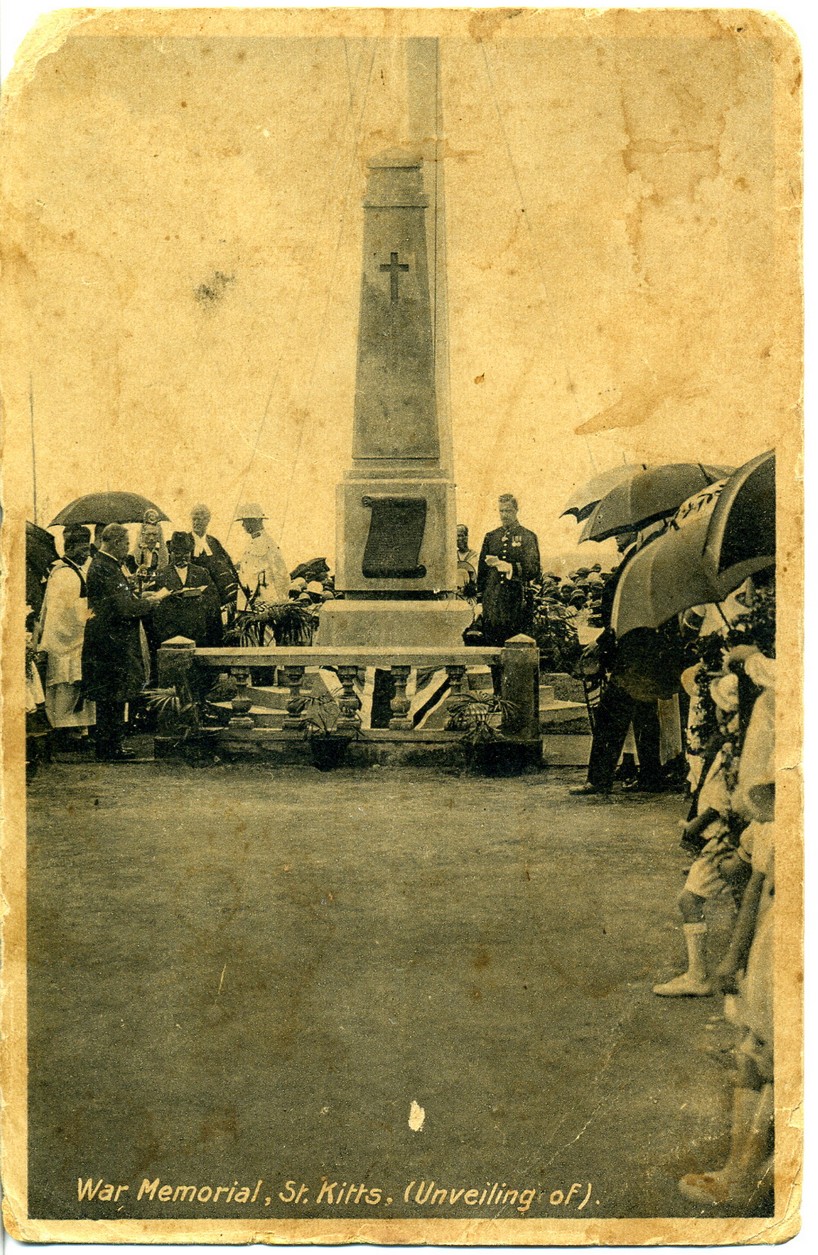

In 1955, following the end of the Second World War, it was moved and replaced by the grander structure and surroundings that can be seen today. The slim white obelisk displays two bronze plaques listing twenty men who died during World War One and six who were killed during World War Two. Three tombs lie in front of the obelisk. Each one is constructed from the stone of one of the three islands which comprised the colony of St. Kitts, Nevis and Anguilla. Every November, the Defence Force, the Police Force and various religious denominations gather at the memorial to remember Kittitians, Nevisians and Anguillians who died in service during the two world wars.
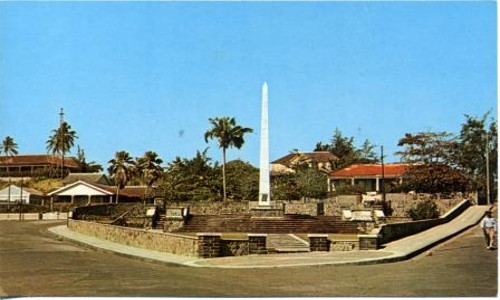
The National Museum
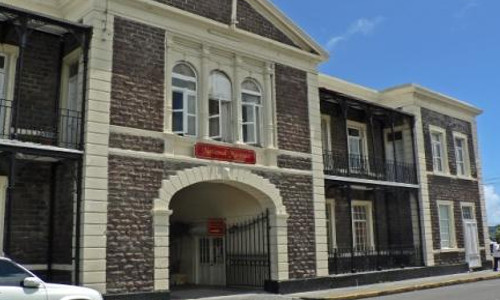
THE NATIONAL MUSEUM is located in what used to be the Treasury Building. It is also the home of the St. Christopher National Trust. Once situated on the Basseterre Bay front, the building is now at the meeting point of Basseterre and the reclaimed land of Port Zante. The Treasury actually moved to the corner of Church Street and Central Street in 1996 and the National Museum gradually moved in.
In 1857 St. Kitts had a new treasury building probably constructed of wood and which included a light house. £600 had been allocated for the project. Before returning the remaining sum to the Treasury, the Committee of Public Buildings bought a clock and placed it on the north side of the building facing Fort Street then deposited the balance of £9 10. 6. It was left over from the project. However in December of that same year money had to be found again for the construction of a privy at the Treasury Building. Why this had not been built in the first instance is anybody’s guess.
By 1883, the discussion on replacing it and extending the pier was well on its way. This was not surprising. Public buildings were generally not maintained well. The location of this particular one made is vulnerable to the Caribbean heat and humidity and exposed it to the sea blast, especially in stormy weather. The proposed building was to be 200 feet in length and 50 feet in width. The foundation was to include piles not less than 12 inches in diameter and spaced 6 feet apart. There were to be 10 rows of piles inclusive of two ends. The walls of the warehouse which was to be located on the ground floor were to be 2 feet thick. The upper floor was to house the offices. It was estimated that the overall cost was to be £3500. And there the matter rested for another five years.
The question of what to do about the building was raised again on the 9th May 1888 by Governor Haynes-Smith. In his address to the Legislative Council he asked the members whether the time has not come to take action as regards to the erection of suitable buildings for the transaction of the public business and the proper storage of goods. Later that year, the merchants of Basseterre petitioned the governor for a new shed on the import pier to protect goods when landed. The matter was placed before the council who advised that the new treasury building should be undertaken and that suitable protection should be provided for the goods that were being imported. The Executive Council was presented the plans and estimates in April 1889. The work had been done by Ivor Moore of the Royal Engineers. The new structure was designed to be an imposing one occupying a significantly larger area than other buildings in the small town. Governor Haynes-Smith and Treasurer Auchenleck felt that the old building was in a terrible state and favoured a new building. Councilors Berkeley, Davis, and Briggs agreed, while Councilors Dr. Semper, Pogson and Evelyn wanted to find out if there was any chance of repairing the old building. The Council was divided on costs with half the members accepting Moore’s estimate of £6000 while the other half felt that it could have been built for £4000.
Despite this general agreement among the members of the St. Kitts Legislature who were normally reluctant to spend extravagantly, the Secretary of State was disinclined to approve the expenditure especially or a stone and iron building. The Governor explained that he had favoured such a structure because good building stone was procurable to the extent that all estates buildings and many of the houses in town were of stone. It was also desirable that the building should be lasting. In view of the objections however he proposed that a new building should be rented when the current Treasury building became unusable but the Council voted to request that the Secretary of State reconsider. Finally in July 1891 it was possible for the Legislature to pass an ordinance to authorise the raising of a loan of £23 500 for the carrying out of a number of projects which, besides the Treasury Building, was were to Include a public library, a leper asylum, new cemeteries, alteration of roads, enlargement of prison, improvement of Cunningham hospital, renovation of the hospital in Nevis, and the construction of one in Anguilla and improvements to the Baths in Nevis. It was to take another two years before the Governor laid the tender for the construction of the new treasury building before the council and asked that duties on materials be remitted. After some discussion the cost of the project was set at £6350 and was won by Gould Brothers, a company originally out of Wales but who had been working in Antigua and Barbados.
The project did not enjoy smooth sailing. In 1894 the contractor had to deal with the problem of procuring white stone which was an outstanding feature of the design. Moore had included this in his drawings because he had seen how the stone had been used at Brimstone Hill and how well it had withstood weathering. The area around Brimstone Hill had this type of stone but it turned out that what was available was unsuitable. Most of the stones were not large enough for the facings and, those that were had flaws. The small quantities that were found, had been used in the structure. The company had incurred a cost of £1046 searching for white stone at Brimstone Hill. Moore insisted on the white stone but he found that the samples procured from Barbados were too course and estimates were obtained for procuring white stone from Bath, England which were prohibitively expensive so the decision was made to use the stone from Barbados. Under the supervision of Mr. Mitchell, the clerk in charge of works for the government on this project and himself a mason, four shipments of the stone was sent up from Barbados. Another problem that the contractors ran into was the lack of skilled labour. This made Governor Haynes Smith think that a technical training school was needed on the island. The fact remained that the building was well over budget. Mitchel recommended its completion for the safety of the building. He calculated that it would take about 6 months. The council voted to stop any further advances to Gould Brothers. In response the contractors offered to cut their losses and supervise the project for 10% of cost which the superintendent of Public Works felt was a good offer. On the 19th September 1895 the Treasurer moved the vote of £1200 to complete the treasury building. He noted that it was a shame to leave it in such an incomplete state and a waste of the thousands that had a ready been spent. He also pointed out that the building was in view of all passing vessels. There was a general agreement that the building had to be completed and the vote was passed.
This final vote might never have been taken but for some very intense negotiations. The island was hit by a depression brought on by the low cost of sugar. The Governor informed the Council that he intended to suspend a number of taxes and proposed that works funded by the Public Loan should be suspended except for the new treasury building, the library, and the purchase of La Guerite which was needed for the expansion of Basseterre. He announced that he intended to make up any deficiencies by using the Immigration Fund. This was the fund that had been set up to assist with the recruitment of indentured labour from parts of the world outside the region. In 1895 this stood at £14,389 15s 9½d. The men on the Legislative Council challenged the Governor’s right to do this. While J T Manchester saw nothing wrong with the proposal, Councilor Gould called the measure “a piece of robbery” and Councilor Horsford said that the government had no moral right to appropriate the Immigration Fund which the planters had entrusted in the government for a specific purpose. He suggested that the government might as well appropriate the funds in the Savings Bank. Horsford also pointed out that the planters had asked for tax relief owing to the difficult situation they were in and that they had proposed that the government might appropriate the fund if this was granted. He objected to the fact that the Secretary of State had disallowed the ordinance suspending certain taxes. The response was given by the Treasurer who argued that most of the fund was accumulated interest resulting from the investment of these monies in securities in England. The present planters 'had neither moral nor legal right to the money'. The government had assisted them by organizing public work that kept the labourers from migrating and therefore placing at the disposal of the planters a quiet and peaceful population. That meant that the purpose for the creation of the fund had been met and the planters had been supplied with better labourers than “coolies and china men”.
The Administrator added weight to the argument by pointing out that the Immigration Fund was nothing like a saving bank. The deposits in the saving bank were personal and private and logged in safekeeping at interest. He pointed out that the planters were owners of nearly all the land in St. Kitts and that labourers were practically in the hands of the planters. There was no peasant proprietorship as an alternative to paid wages. The final ordinance giving government access to the Immigration Fund was approved on the stipulation that if money was required for immigration purposes it would not come out of the pockets of the planters.
The foundation stone which is located on the southern side of the building was laid by Lady Haynes-Smith the wife of the then Governor Sir William Haynes-Smith on the 21st of March 1894. After completion the Treasury also housed the offices of the Administrator, Customs, Audit, Supply and Post Office. Once again a light house was placed in the dome at the top. For many years, it guided hundreds of captains of the boats and ships that docked at the wooden treasury landing pier over the Caribbean Sea which continued the line through the archway to Fort Street.
The symmetry and mass of the building was a manifestation of the colonial authority of Britain. While its equally sized apertures, and framing contrasted masonry communicated a sense of discipline and order. Once called the Gateway to the Island, the gated archway produced a sense of a controlled admittance into the town for all arrivals in the years of sea travel. The archway served another purpose. It divided the ground floor it two allowing for air circulation to offices that might have become too hot in a tropical climate.
Today the wooden pier that once lead from the boats to the building has been replaced by an apron leading to Port Zante, the new gateway into Basseterre, on which cruise ships dock.
National Archives
Government Headquarters
Church Street
Basseterre
St. Kitts, West Indies
Tel: 869-467-1422 | 869-467-1208
Email: NationalArchives@gov.kn
Website: www.nationalarchives.gov.kn
Follow Us on Instagram

